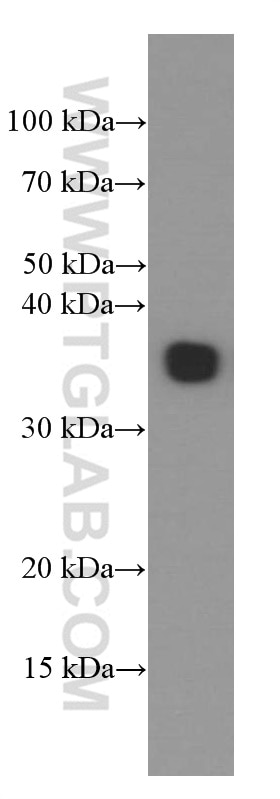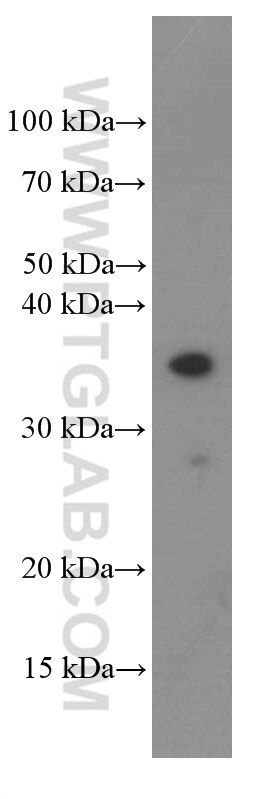Validation Data Gallery
Tested Applications
| Positive WB detected in | human spleen tissue, rat spleen tissue |
Recommended dilution
| Application | Dilution |
|---|---|
| Western Blot (WB) | WB : 1:500-1:2000 |
| It is recommended that this reagent should be titrated in each testing system to obtain optimal results. | |
| Sample-dependent, Check data in validation data gallery. | |
Product Information
66354-1-Ig targets EBI3 in WB, ELISA applications and shows reactivity with human, pig, rat samples.
| Tested Reactivity | human, pig, rat |
| Host / Isotype | Mouse / IgG1 |
| Class | Monoclonal |
| Type | Antibody |
| Immunogen | EBI3 fusion protein Ag3051 相同性解析による交差性が予測される生物種 |
| Full Name | Epstein-Barr virus induced 3 |
| Calculated molecular weight | 229 aa, 25 kDa |
| Observed molecular weight | 34 kDa |
| GenBank accession number | BC015364 |
| Gene Symbol | EBI3 |
| Gene ID (NCBI) | 10148 |
| RRID | AB_2881734 |
| Conjugate | Unconjugated |
| Form | Liquid |
| Purification Method | Protein G purification |
| UNIPROT ID | Q14213 |
| Storage Buffer | PBS with 0.02% sodium azide and 50% glycerol , pH 7.3 |
| Storage Conditions | Store at -20°C. Stable for one year after shipment. Aliquoting is unnecessary for -20oC storage. |
Background Information
EBI3, a 34-kDa secreted glycoprotein, is a subunit in 2 distinct heterodimeric cytokines: IL-27 and IL-35. IL-27, composed of p28 (IL-27) and EBI3, can trigger signaling in T cells, B cells, and myeloid cells. IL-35, composed of EBI3 and the ubiquitously expressed p35 subunit of IL-12, is an inhibitory cytokine involved in regulatory T-cell function. EBI3 plays a role in regulating cell-mediated immune responses. (PMID: 8551575; 18033300; 17874423; 21931777)
Protocols
| Product Specific Protocols | |
|---|---|
| WB protocol for EBI3 antibody 66354-1-Ig | Download protocol |
| Standard Protocols | |
|---|---|
| Click here to view our Standard Protocols |

